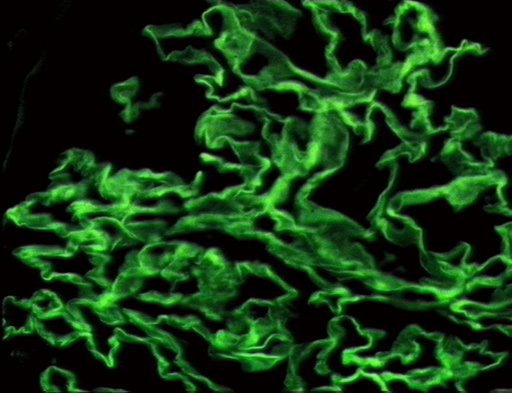Goodpasture syndrome pathophysiology: Difference between revisions
| Line 4: | Line 4: | ||
==Overview== | ==Overview== | ||
==Pathogenesis== | ==Pathogenesis== | ||
The pathogenesis of Goodpasture syndrome is the presence of autoantibodies against the glomerular or alveolar basement membranes. The target antigen that has the strongest pathogenic effect on anti-GBM disease is the non-collagenous 1 domain of alpha-3 type IV collagen. There are 2 dominant epitopes, they are epitope A and epitope B. These epitopes are seen in the alpha-3 non-collagenous 1 domain of type IV collagen and antibodies do not normally bind unless a change has occurred in the non-cross linked hexamers or trimers. In Goodpasture syndrome these epitopes undergo a transitional change in the non-cross linked hexamers or trimers. This allows antibodies to be bound to the epitopes | The pathogenesis of Goodpasture syndrome is the presence of autoantibodies against the glomerular or alveolar basement membranes. The target antigen that has the strongest pathogenic effect on anti-GBM disease is the non-collagenous 1 domain of alpha-3 type IV collagen. There are 2 dominant epitopes, they are epitope A and epitope B. These epitopes are seen in the alpha-3 non-collagenous 1 domain of type IV collagen and antibodies do not normally bind unless a change has occurred in the non-cross linked hexamers or trimers. In Goodpasture syndrome these epitopes undergo a transitional change in the non-cross linked hexamers or trimers. This allows antibodies to be bound to the epitopes. The pathogenic role of epitopes such as epitope A, has been shown to affect the function of the renals, especially of the alpha-3 type IV collagen of non-collagenous 1 domain. Epitope B however is not able to induce Goodpasture syndrome by itself. | ||
The cause of renal injury is due to anti-glomerular basement membrane antibodies ability to bind and activate complements and proteases. This processes causes an | |||
interruption between the filtration barrier and the Bowman’s capsule to occur. When the filtration barrier and the Bowman's capsule are interrupted, this process induces a crescent formation of the renal as well as proteinuria. Injury to the renal induces T cells (CD4+ and CD8+), macrophages, and neutrophils. | |||
The factors that are associated with this process are due to oxidation, nitrosylation, glycation, increases in body temperature, or proteolytic cleavage. For example, it has been shown that proteolytic cleavage of disulfide bonds in non-cross linked hexamers has shown greater affinity for Goodpasture syndrome antibodies to bind. Environmental factors are also said to attribute to the disease such as exposures to hydrocarbons, exposure to formaldehyde or smoking tobacco. Smoking tobacco for instance causes sulfilimine bond substances to be inhibited. Inhibition of the sulfilimine bond substances cause non-cross linked hexamers to form. | |||
== Pathophysiology == | == Pathophysiology == | ||
Revision as of 19:10, 2 November 2016
|
Goodpasture syndrome Microchapters |
|
Diagnosis |
|---|
|
Treatment |
|
Case Studies |
|
Goodpasture syndrome pathophysiology On the Web |
|
American Roentgen Ray Society Images of Goodpasture syndrome pathophysiology |
|
Risk calculators and risk factors for Goodpasture syndrome pathophysiology |
Editor-In-Chief: C. Michael Gibson, M.S., M.D. [1]
Overview
Pathogenesis
The pathogenesis of Goodpasture syndrome is the presence of autoantibodies against the glomerular or alveolar basement membranes. The target antigen that has the strongest pathogenic effect on anti-GBM disease is the non-collagenous 1 domain of alpha-3 type IV collagen. There are 2 dominant epitopes, they are epitope A and epitope B. These epitopes are seen in the alpha-3 non-collagenous 1 domain of type IV collagen and antibodies do not normally bind unless a change has occurred in the non-cross linked hexamers or trimers. In Goodpasture syndrome these epitopes undergo a transitional change in the non-cross linked hexamers or trimers. This allows antibodies to be bound to the epitopes. The pathogenic role of epitopes such as epitope A, has been shown to affect the function of the renals, especially of the alpha-3 type IV collagen of non-collagenous 1 domain. Epitope B however is not able to induce Goodpasture syndrome by itself. The cause of renal injury is due to anti-glomerular basement membrane antibodies ability to bind and activate complements and proteases. This processes causes an interruption between the filtration barrier and the Bowman’s capsule to occur. When the filtration barrier and the Bowman's capsule are interrupted, this process induces a crescent formation of the renal as well as proteinuria. Injury to the renal induces T cells (CD4+ and CD8+), macrophages, and neutrophils.
The factors that are associated with this process are due to oxidation, nitrosylation, glycation, increases in body temperature, or proteolytic cleavage. For example, it has been shown that proteolytic cleavage of disulfide bonds in non-cross linked hexamers has shown greater affinity for Goodpasture syndrome antibodies to bind. Environmental factors are also said to attribute to the disease such as exposures to hydrocarbons, exposure to formaldehyde or smoking tobacco. Smoking tobacco for instance causes sulfilimine bond substances to be inhibited. Inhibition of the sulfilimine bond substances cause non-cross linked hexamers to form.
Pathophysiology
As with many autoimmune conditions, the precise cause of Goodpasture’s Syndrome is not yet known. It is believed to be a type II hypersensitivity reaction to Goodpasture’s antigens on the cells of the glomeruli of the kidneys and the pulmonary alveoli, specifically the basement membrane's (including a-3 chain of type IV collagen), whereby the immune system wrongly recognizes these cells as foreign and attacks and destroys them, as it would an invading pathogen.
Pathology
